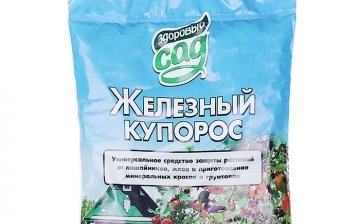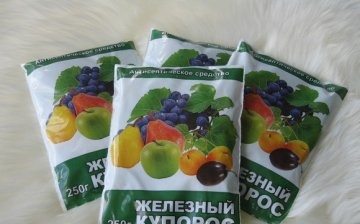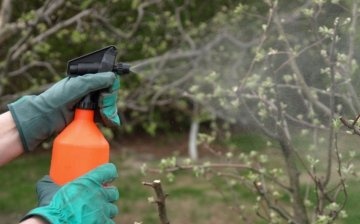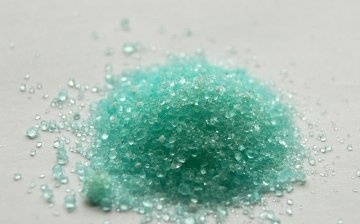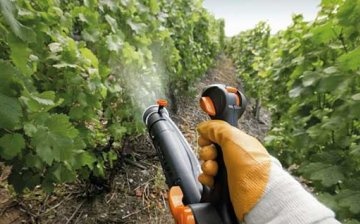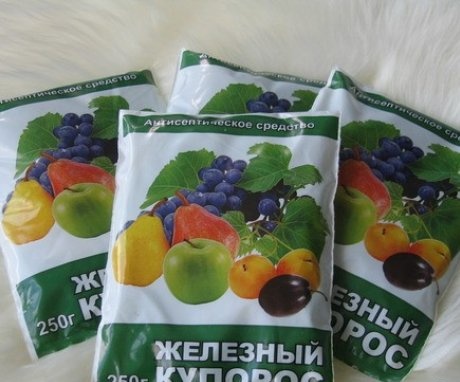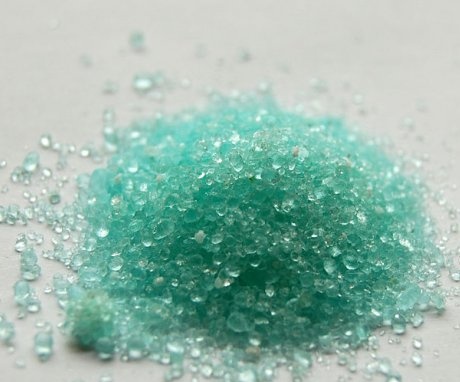Iron vitriol: instructions and correct use in gardening
People who grow plants in the garden or vegetable garden are familiar with this effective drug. In most cases, when diseases occur or for prevention, inexperienced farmers prefer various types of chemicals and pesticides.
But the use of ferrous sulfate brings much more positive results than modern methods of struggle. At the same time, the effect of the insecticide is less harmful to fruit crops than when using other means.
Content:
- What is this drug?
- When and why is it used in the garden?
- Concentration and consumption rates
- Terms of use and precautions
What is this drug?
Iron vitriol (ferrous sulfate II) acts as a chemical insecticide, designed to fight diseases provoking a fungus, as well as the appearance of moss growths on tree trunks and lichens. The chemical is produced in the form of small granules of a pale green or light green shade with a gray admixture, and is also sold in the form of a loose powder. The product in any form dissolves easily in liquid.
The composition of the fungicide consists of a salt (53%), which was formed upon contact of sulfuric acid combined with crystalline hydrate and ferrous iron.
Insecticide treatment in the first spring months slows down bud break and inhibits the awakening of the whole plant. Such a process has both positive results under certain weather conditions and a negative effect.
Gardeners use a complex scheme for influencing diseases and parasites. In March-April, spraying with copper is carried out, and in autumn, irrigation with iron sulfate is carried out. This is due to the fact that iron II sulfate does not always effectively cope with diseases provoked by fungi. Spores can persist in secluded corners, under the bark, leading to re-infection.
When and why is it used in the garden?
Iron sulfate is often used as a fertilizer, as well as a substance for disinfecting greens and bark of fruit crops. In addition, the drug is used as fungicide and an insecticide. The diluted consistency of iron sulfate appears with an increased level acidity... This negatively affects green foliage, if the fungicide is sprayed on young leaf blades, it can cause burns.
Therefore, the procedure for influencing trees and shrubs is carried out only in early spring, before the beginning of the growing season of plants. In addition to the first spring month, the event is allowed to be held in the fall - after the harvest and the complete fall of the foliage.
The first reason why a culture is exposed to a fungal disease is fallen leaves. If it is not removed, spores of fungi begin to develop inside its accumulation, which provoke the disease. Foliage harvested at the wrong time can transmit dangerous diseases from the ground to the trunk and branches. It is recommended both in spring and autumn to disinfect not only the ground part of the plants, but also the soil under them.
It is best to carry out spraying activities in the fall.
It is at this moment that it is easy to collect freshly fallen, not rotted foliage and burn it.Before carrying out the procedure, it is recommended to loosen the near-trunk soil to a depth of 15 cm. This will provoke the rise to the surface of pathogenic bacteria and parasites that have lain near the root system for the winter.
Gardeners purchase ferrous sulfate II for use in the following situations:
- For treatment against tree diseases for the spring and autumn period.
- To eliminate pests from branches and bark, as well as their larvae, and eggs laid for the future.
- For irrigation of the site - many farmers use a chemical agent to fertilize the area, due to the fact that the drug contributes to the saturation of the soil with iron. Such feeding has a beneficial effect on increasing the growth of plantings.
- While digging up the soil, introducing the drug along with humus into the soil.
- For neutralizing scab or black cancer.
- For therapy powdery mildew (real and false), coccomycosis, anthracnose or gray rot.
- For the treatment of various colors, including roses from spotting.
- For preventive measures on grapes.
- For processing sections after pruning, so that pathogenic bacteria or pests do not join the plant.
Iron vitriol is not intended for processing indoor flowers. It is used exclusively for the impact on fruit crops placed in the open field. Thus, the insecticide has a wide spectrum of action. It is used not only to eliminate disease-causing bacteria, but also as a growth stimulant into the earth.
Concentration and consumption rates
So that the drug instead of the good does not cause even more harm, it is required to precisely maintain the required concentration of the solution. To do this, you need to accurately follow the dosage for diluting the essence.
The following norms are distinguished for the correct effect on various fruit crops:
- To eliminate moss or lichens on the bark of trees, a liquid is used, with a 5% concentration of the drug - 600 g. iron sulfate powder per 10 liters. liquids.
- Ferrous sulfate solution for pears, grapes, quince, apple trees requires 4% of the composition of the fungicide - up to 500 gr. granules of fungicide on a bucket of liquid. In this case, the water consumption should not exceed 10 liters. per 100 m2.
- Stone fruits (apricot, sweet cherry, peach, cherry, plum) are irrigated with a 3% solution: 0.3 g is diluted per 10 liters of liquid (a bucket of water). powder. Spraying is carried out in the fall before preparing for winter (shelter), after the foliage has completely fallen off along the bare shoots.
- Disinfection of cellars from various fungal diseases requires a highly concentrated essence - 500 gr. insecticide on a bucket of water.
- As a preventive measure, irrigation with a 1% solution is performed. This requires no more than 150 grams. granules of the drug diluted by 15 liters. liquids.
Other shrubs with a delicate leaf structure need an even greater reduction in the concentration of the solution. This is necessary to avoid burns on the leaves. The spraying event takes place on a warm, windless day. It is best to implement the procedure either in the morning before sunrise, or late in the evening, when the rays of the sun disappeared beyond the horizon.
If the sun is not expected on the scheduled day, and the weather is cloudy, then spraying is performed if there is an exact certainty that there will be no rain in the near future. Otherwise, if precipitation falls, the whole procedure will be in vain.
Thus, while carrying out work to combat diseases and pests, one should be guided by the main rule - not to harm the plant. Therefore, it is better to dilute the required amount of essence with a minimum dosage than to increase the rate and burn the entire foliage of the plant.
Terms of use and precautions
Iron sulfate is not as dangerous as copper sulfate. He has level 3 danger. This suggests that the drug is not able to spontaneously ignite or explode without human help.
When handling the substance, it is not necessary to wear a protective gown and gloves. The main thing. It is required to ensure that the substance does not get on the mucous membrane of the eyes or mouth. If any amount of a highly concentrated 5% substance gets on the skin of a person, you urgently need to wash your hands under a large amount of running water using laundry soap.
It is strictly forbidden to store fungicide next to food.
For chemicals, it is recommended to have a storage area in a garage or utility room. It is believed that it is better to use the drug in the fall than in the first months of spring. This is due to the fact that foliage has already flown from the trees and shrubs and cannot be burned, which happens in spring, if it is too late to carry out the procedure.
In the autumn period, the event is most important due to the fact that harmful parasites and bacteria can settle on the bark and in the sections, which provoke diseases. Carrying out processing saves not only this culture, but also the entire personal plot. Thus, ferrous sulfate is a remedy for eliminating diseases, pests, and also serves as a fertilizer to replenish iron reserves in the soil. Its use allows you to grow healthy fruit crops and enjoy their ripe and healthy fruits.
More information can be found in the video:



